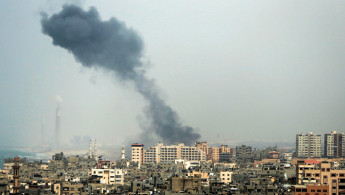Hamas levels an 'ancient archaeological Gaza site'
Beneath the destruction, poverty and human suffering in Gaza lies a world of archaeology.
Among the historical sites in the besieged enclave, is Tel Es-Sakan (hill of ash), which according to Palestinian archaeology and history professor Mouin Sadeq was the largest Canaanite city between Palestine and Egypt.
It was named after the great amount of ash found during the excavations, which suggests the settlement was burnt either naturally or during war.
Archaeologists found the 10-hectare (25-acre) hill to be hiding a fortified settlement built centuries before pharaonic rule in Egypt, and a thousand years before the pyramids were constructed. But the excavations stopped in 2002 due to security concerns.
Palestinian and French archaeologists began digging into Gaza's earliest archaeological site nearly 20 years ago, unearthing what they believe is a rare 4,500-year-old Bronze Age settlement.
Gaza's Hamas rulers have systematically destroyed their work recently, the archaeologists told AP. The Gaza-based authority allowed for the flattening of this hill on the southern tip of Gaza City to make way for new construction projects, some of which could later become military bases.
In its newest project, Hamas-supported bulldozers are flattening the last remnants of excavation.
With little open space in Gaza - commonly defined as an open-air prison - a fast-growing population and an economy stifled by Israeli and Egyptian blockades, Hamas officials say they have no choice but to develop the area, making archaeology a low priority.
Pressures on Hamas to stop the recent flattening increased last month.
"Today, the complete southern facade of the Tel is erased," said Jean-Baptiste Humbert, a Jerusalem-based archaeologist at the Ecole Biblique who had excavated sites in Gaza.
In previous years, faces and ramparts on other sides were also destroyed. "Now it is destroyed all around," he added.
In 2009 and 2012, the expansion of Gazan universities destroyed the western and northern facades of Tel El-Sakan. On the eastern side, temporary dwellings were set up to house displaced people as a result of Israel's offensives on the besieged enclave.
The southern front remained, but Hamas now says it needs the land to compensate some of its senior employees, who have only received partial salaries.


![President Pezeshkian has denounced Israel's attacks on Lebanon [Getty]](/sites/default/files/styles/image_684x385/public/2173482924.jpeg?h=a5f2f23a&itok=q3evVtko)



 Follow the Middle East's top stories in English at The New Arab on Google News
Follow the Middle East's top stories in English at The New Arab on Google News


